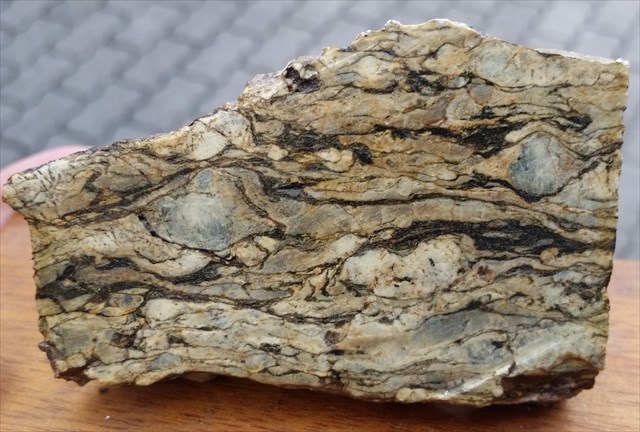
 |
Augengneis in Schauenstein |
|
Die geologische Lage Schauensteins
Ein Blick auf die geologische Karte in Bayern verrät: Schauenstein nimmt eine Sonderstellung in der Region ein. Hier trifft der Frankenwald mit seinen Schieferböden auf die Münchberger Gneismasse, die aus komplett anderen Gesteinen besteht. Bohrungen haben ergeben, dass die Gneismasse den Frankenwald (geologisch: Thüringisch-Fränkisch-Vogtländische Faszies) hier überlagert. Die Münchberger Gneismasse endet in der Region um Schwarzenbach / Saale. Hier kommt das Frankenwaldgestein nochmal ganz kurz nach oben, danach beginnt das wesentlich jüngere Fichtelgebirge mit seinem Granitgestein. An den Reibungspunkten der Grenze Frankenwald / Münchberger Gneismasse sind Augengneise entstanden - das Thema dieses Earth-Caches.
Es ist faszinierend, wie genau definierbar diese Reibungslinie ist. Augengneise finden sich zum Beispiel am Schauensteiner Schloss, am Fuchsbau, und dann wieder von Grafengehaig bis Kupferberg. Schon wenige 100 Meter östlich dieser Linie sind keine Augengneise mehr vorhanden. Die Felsformation “Schlafender Riese” zum Beispiel enthält keine augenförmigen Feldspate.
In der anderen Richtung ergibt sich dasselbe Bild: Kaum hat man die Straße Windischengrün - Schauenstein - Uschertsgrün überquert, findet man bereits rötlichen Schiefer, den sogenannten Randschiefer.
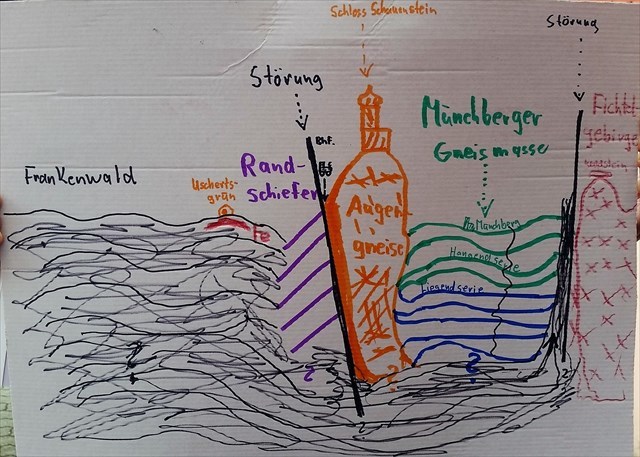 Schematische Darstellung der geologischen Lage Schauensteins. Zeichnung v. K. Rauh
Schematische Darstellung der geologischen Lage Schauensteins. Zeichnung v. K. Rauh
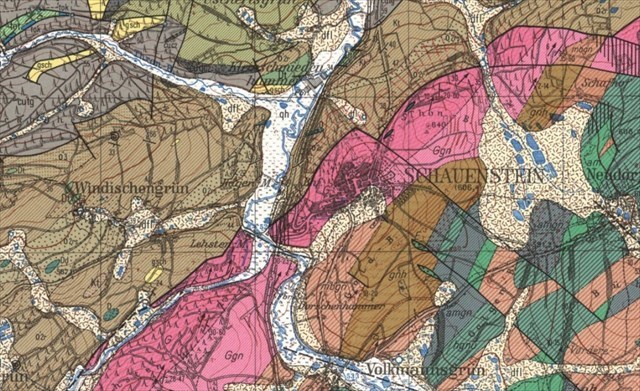 Geologische Karte Schauensteins. Größere Übersichtskarte und Erläuterungen zu den Farben sh. Fotogalerie und untenstehende Links zum Landesamt für Umwelt
Geologische Karte Schauensteins. Größere Übersichtskarte und Erläuterungen zu den Farben sh. Fotogalerie und untenstehende Links zum Landesamt für Umwelt
Die Entstehung der Münchberger Gneismasse
Die Entstehung der Münchberger Gneismasse ist bis heute nicht geklärt. Es gibt zwei Theorien, wie dieser “Fremdkörper” zwischen dem Frankenwald und dem Fichtelgebirge landen konnte.
Die erste Theorie besagt, dass das Gestein von tief unter der Erde nach oben wanderte.
Die zweite und derzeit mehrheitlich befürwortete Theorie besagt, dass die Gneismasse aus der Gegend Erbendorf-Vohenstrauß etwa 100 nach Münchberg wanderte. Hierbei müssen enorme Kräfte gewirkt haben, denn die Gneismasse ist 500km² groß und 6km dick!
Die Münchberger Gneismasse besteht aus mehreren Schichten. Die oberste Schicht ist zugleich die älteste Schicht, die Schichten liegen also verkehrt herum.
Granit und Gneis
Ausgangsbasis für unseren Augengneis ist der Granit, ein vulkanisches Gestein. Viele Earth-Caches zum Thema Granit fragen “ist die Magma hier langsam oder schnell abgekühlt?”. Daher jetzt aufpassen und merken: Je langsamer die Magma abkühlt, umso größer werden die Kristalle. “Feldspat, Quartz und Glimmer, die drei vergess ich nimmer”, so lernt man in der Schule. Das sind die drei Hauptbestandteile des Granits.
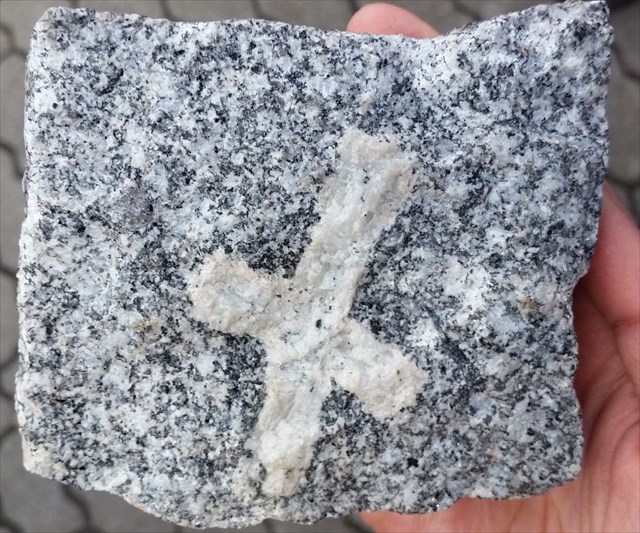 Granit mit großem Feldspat vor Metamorphose. Sammlung K. Rauh
Granit mit großem Feldspat vor Metamorphose. Sammlung K. Rauh
Gneis ist ein sogenanntes metamorphes Gestein, das heißt, ein anderes Gestein hat sich durch Druck und Hitze verändert. Der benötigte Druck und die Hitze kommen meist von Plattenbewegungen oder Gebirgsbildungen - so einfach lässt sich ein Stein nämlich nicht verformen! Bei der Umwandlung wird die chemische Zusammensetzung des Steins nicht verändert. Die Textur oder die Ausrichtung der Kristalle ändert sich. Hier in Schauenstein ist Granit ist der Ausgangsstein für die Umwandlung. Das nennt man “Orthogneis”. Wenn sich Schiefer oder Sandstein umwandelt, nennt man das Endergebnis Paragneis.
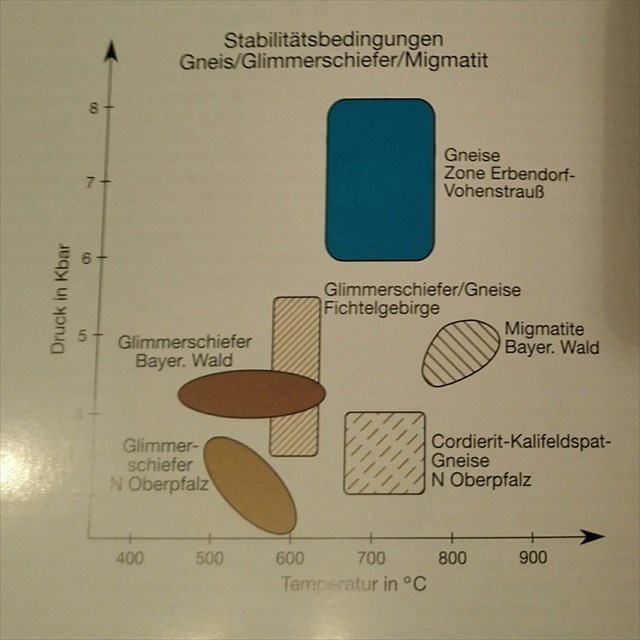 Der Gneis in der Münchberger Masse (entspricht in etwa den Gneisen der Zone Erbendorf-Vohenstrauß) war besonders hohem Druck ausgesetzt. Quelle: Broschüre des Bay. Geologischen Landesamtes
Der Gneis in der Münchberger Masse (entspricht in etwa den Gneisen der Zone Erbendorf-Vohenstrauß) war besonders hohem Druck ausgesetzt. Quelle: Broschüre des Bay. Geologischen Landesamtes
Andere Beispiele für diese Metamorphose ist zum Beispiel Marmor (Metamorphose von Kalkstein, Amphibolit (Metamorphose von Basalt - laut der geologischen Karte steht Ahornberg übrigens auf Amphibolit) und Eklogit (größtes Vorkommen: der Weißenstein bei Stammbach). Oft wird in EarthCaches zum Thema Marmor gefragt: “Kannst du Fossilien im Stein erkennen?”. Wer in einem metamorphen Gestein Fossilien findet, hat den Nobelpreis sicher. Es ist nicht vorstellbar, dass eine Urzeitschnecke dem enormen Druck, der sogar Granit verändert, standhalten könnte.
Augengneis
Unser Schauensteiner Ausgangsgranit ist also irgendwann noch einmal abgetaucht und hat seine Transformation zum Gneis begonnen. Der Granitstein wurde etwas weich (nicht flüssig) und die Feldspate fingen an zu rotieren und schliffen sich dabei ab. Das kann man sich vorstellen wie das Ausrollen eines Nudelteigs. Es entstanden ellipsenförmige Feldspateinlagerungen, die auch Alexander von Humboldt untersuchte. Heute seid ihr dran!
LOGGEN:
Du kannst sofort loggen und mir die Antworten später senden.
Denke daran: Wenn du deine Antworten nicht in angemessener Zeit sendest, kann ich deinen Log ohne Ankündigung löschen.
Fragen:
- Betrachte den Augengneis-Aufschluss vor Ort (den Stein mit der Infotafel und dem Baum darauf) und suche die “Augen” vorne und seitlich. Wie groß sind die kleinsten, wie groß die größten Augen?
- Wieso sind die Feldspat-Kristalle hier in Schauenstein nicht mehr eckig, sondern augenförmig?
- Erkläre in deinen eigenen Worten den Unterschied zwischen Gneis und Granit.
- Schauenstein liegt auf einer geologischen Störung. Kann das zu Erdbeben führen? Begründe deine Meinung.
Quellen und weitere Informationen:
Zum Lösen des Caches nicht benötigt, aber interessant für die weitere Recherche bei Interesse am Thema:
Vielen Dank außerdem an Herrn K. Rauh, Helmbrechts, für die vielen Informationen zu diesem Thema.



 |
Gneisses with quartz eyes |
|
The geological position of Schauenstein
Looking at a geological map of Bavaria, it’s easy to see: The position of Schauenstein is very special in this region. Here, the franconian forest meets the Münchberg gneiss formation, an area with a completely different type of stones. Test drills revealed: The Münchberg gneiss formation covers the Frankenwald here. (Geologically you wouldn’t call it Frankenwald, but thuringian-bavarian-vogtland slate mountains). The Münchberg gneiss formation ends in the region of Schwarzenbach / Saale. Here, the Frankenwald stones rise for a short stretch, and meet the much younger granitic stones of the Fichtelgebirge. This earth cache is all about the borders and the scrubbing of the Münchberg gneiss formation.
It’s fascinating to see how clearly visible the borders between the geological areas are. Along this border we can find gneiss with eye-shaped quartzes. We find them at the castle in Schauenstein, at the geological formation called “Fuchsbau”, and then again on the stretch between Grafengehaig and Kupferberg. Outside the city of Schauenstein there’s another stone formation called “sleeping giant” (Schlafender Riese) - this rock is some 100 meters away from this border and does not contain eye-shaped quartz. So, the area where we can find this geological curiosity is really narrow!
It’s the same thing moving in the other direction, crossing the street Windischengrün - Schauenstein - Uschertsgrün. Cross the street and you begin to see reddish slate, the so called border slate. Slate is the sign: You are now in the Frankenwald.
The creation of the Münchberg gneiss formation
Scientists are still arguing about the history of this gneiss formation. There are two major theories to explain how this foreign stone could arrive here in the region. The first theory says that the gneiss rose up from deep down in the earth. The second theory, which is more acknowledged, says that the formation travelled to Münchberg coming from the area of Erbendorf-Vohenstrauß, as the geology of Erbendorf-Vohenstrauß is similiar to the Münchberg gneiss formation. There are even eye-shaped quarzes there!
if this theory is true, imagine the incredible force of the earth that was necessary to shift this 500 km² and 6km high rock layer for about 100km!
The Münchberg gneiss formation consists of various layers which are upside down. The older layers are on top, the younger layers can be found further down.
Granite and Gneiss
Granite, a volcanic rock, is the base for our Schauenstein gneiss with quartz-shaped eyes. Maybe you have solved earth caches about granite before. Often you will see the question “did the magma cool down slowly or quickly here?”. The slower the magma cools down, the bigger are the crystals in the granite. The three most important components of granite are feldspar, quartz and mica. In the german translation there’s a nice rhyme to remember these ingredients, but it doesn’t make sense in the english translation.
Gneiss is a metamorphic rock. This means that it used to be another rock (for example granite) and has been transformed by immense pressure and heat. This pressure and heat derives mostly from tectonic movements - because it’s not that easy to squeeze a granite stone! In the process of the transformation, the chemical composition is not altered. Only things like texture and the symmetry of the crystals change.
Here in Schauenstein, the gneiss was created from a granite stone as a base. This is what you call Orthogneiss. If slate or sandstone are the base for the transformation, you’ll call the result Paragneiss. In the text of the german translation you’ll see an illustration of the pressure and heat needed to create the Münchberg gneiss formation.
Gneiss is not the only metamorphic rock. Just think of marble, a metamorphic rock based on calcite! Metamorphic basalt is called Amphibolit, this rock can be found in the Münchberg gneiss formation as well! Also Eklogit is a metamorphic rock and it’s really rare - the biggest example of it can be found at the Weißenstein near Stammbach, just a couple of kilometers from here.
There are thousands of earth caches about marble (just travel to Rome…) and a very popular question here is “Can you find fossils in the marble?”. If you can find fossils in any metamorphic rock, it’s likely that you’ll get the nobel prize straight away. If you’re lucky you’Ll even get two of them. Imagine how much force and pressure was needed to “knead” the granite and make it become gneiss - do you really think a little prehistoric snail would survive this process?
Gneiss with eye-shaped quartz
So, the granite that would become our “gneiss with eyes” somehow dived down into the earth and became soft. Not liquid, otherwise we wouldn’t have gneiss now. Imagine it like a pizza or cake dough. The feldspar began rotating and this movement cut the edges. The feltspar turned out ellipse shaped and resembles eyes in certain points. Also the scientist Alexander von Humboldt stood here and examined this phenomenon. And now it is your turn!
TO LOG:
You might log immediately and send me the answers later on.
Keep in mind: If you don’t send your answers in a couple of days, I can delete your log without previous announcement at any time..
Questions:
- Find the Augengneiss rock and examine it (there’s also a small information panel and a tree on top of the rock). Search the “eyes” in front and on the sides. What size do the eyes have (the smallest ones and the biggest ones?
- Why are the feltspar crystals here not rectangular but elliptic (eye-shaped)?
- Explain in your own words the difference between granite and gneiss.
- Schauenstein has been built on top of a geologic disturbance. Could this lead to earth quakes here? Explain your opinion.



